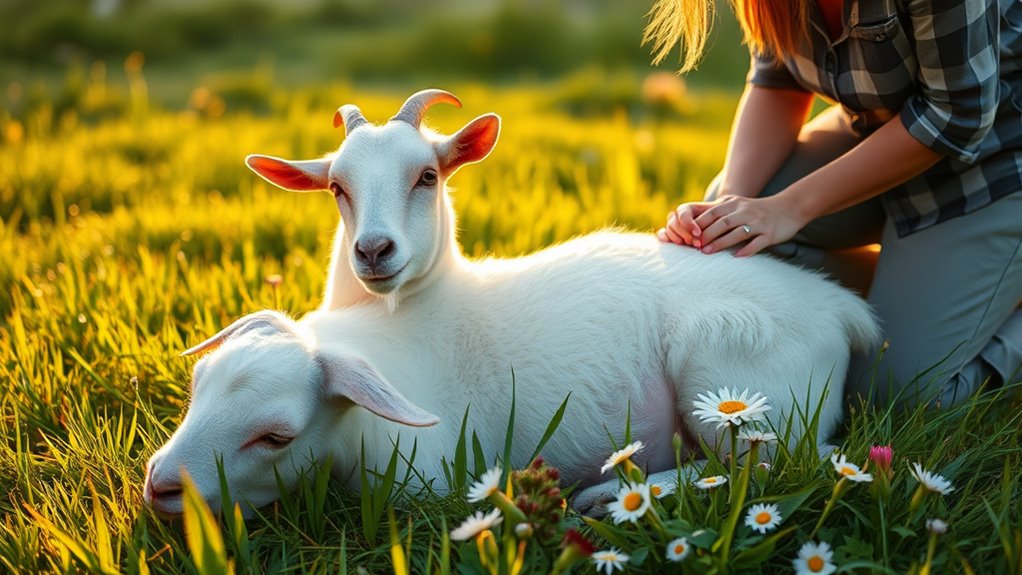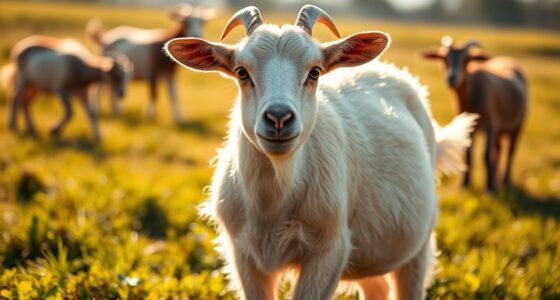Caring for pregnant goats is crucial for healthy kids and happy does. You'll want to monitor their 150-day gestation period and provide a nutritious diet rich in protein and carbohydrates. Regular health checks and vaccinations are key to preventing issues. Prepare a clean, draft-free shelter for kidding, and gather essential supplies. After birth, ensure the kids get colostrum and keep an eye on their health. There's a lot more to consider for a successful pregnancy journey.
Key Takeaways
- Monitor gestation length of 145 to 155 days, using a goat gestation calculator for accurate due dates.
- Provide a balanced diet with 14% to 16% protein, ensuring access to fresh water and mineral supplements.
- Conduct regular health checks and vaccinations, especially against Clostridium perfringens and tetanus in the last month of pregnancy.
- Prepare a clean, comfortable kidding area with proper ventilation and heat sources if necessary.
- Ensure newborns receive colostrum immediately and care for the umbilical cord to prevent infection.
Understanding the Gestation Period
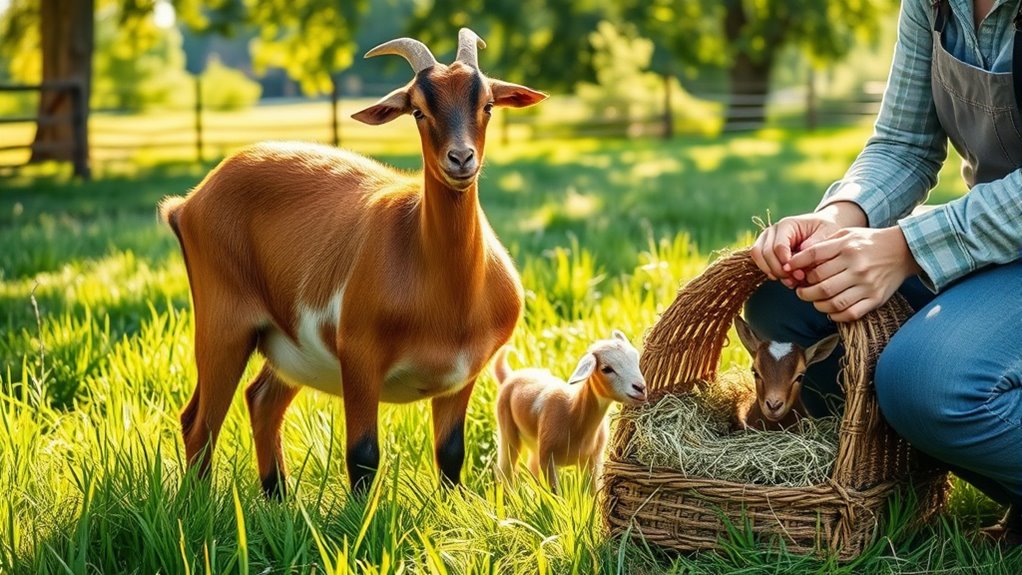
Understanding the gestation period for goats is crucial for successful breeding and care. The average duration is about 150 days, but it can range from 145 to 155 days based on breed and individual traits.
Standard breeds usually fall around 150 days, while miniature breeds may have a shorter gestation of about 145 days. Factors like breed size, estrus cycle, and whether it's the doe's first pregnancy can influence this length.
To calculate due dates, using a goat gestation calculator is helpful; simply add the gestation period to the breeding date. Keeping accurate records of breeding and birth dates is essential for predicting future gestation lengths and managing your herd's overall health effectively.
Nutritional Requirements During Pregnancy
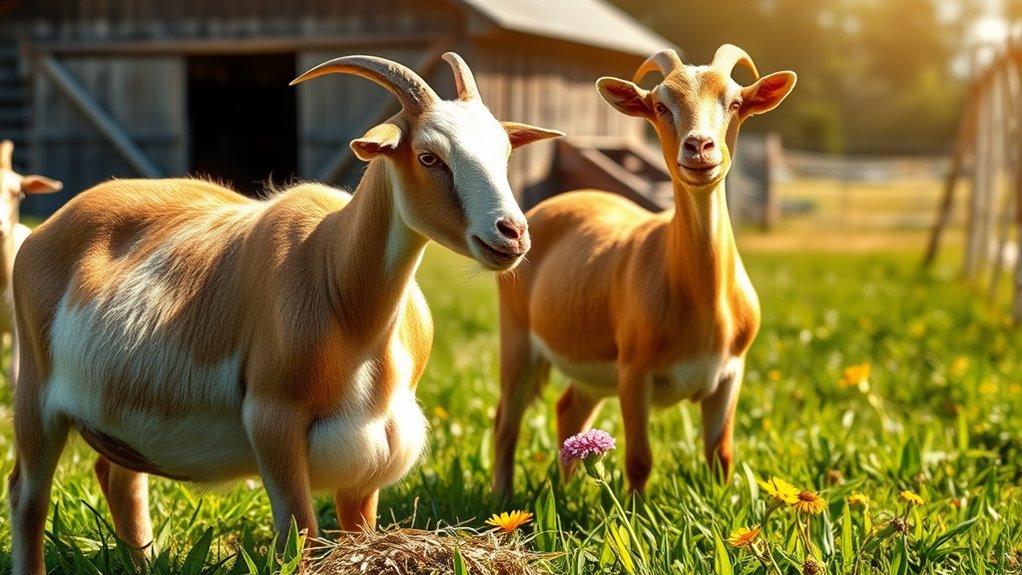
During pregnancy, goats have specific nutritional requirements that are vital for both maternal health and fetal development.
Goats require tailored nutrition during pregnancy to ensure the health of both mother and developing kids.
You'll want to ensure they've access to plenty of fresh water, about 0.5 to 1.5 gallons daily. A diet rich in carbohydrates from forage like pasture and hay provides essential energy, while fats in concentrates further boost energy levels.
Aim for a protein content of 14% to 16% to support fetal growth, incorporating sources like legume hays and soybean meal. During the last 50 days of pregnancy, energy needs increase significantly, so consider supplementing with concentrates.
Monitor your goat's body condition and adjust feed amounts accordingly, ensuring she thrives throughout her pregnancy.
Importance of Mineral Supplements

Mineral supplements are essential for pregnant goats, as they help maintain overall health and meet the increased nutritional demands during gestation.
These supplements support vital functions like reproduction and energy metabolism, preventing deficiencies that can arise from variable forage quality. Without proper minerals, you may see poor reproductive performance, which can lead to higher costs per kid and reduced herd productivity.
Key minerals like calcium, phosphorus, and selenium are crucial for bone health, energy utilization, and immune function.
By providing free-choice access to palatable, goat-specific mineral supplements year-round, you ensure your goats receive the nutrients they need.
Regularly monitoring intake and consulting with a veterinarian can help optimize your herd's health and productivity during this critical period.
Health Checks and Vaccinations

To ensure the health of pregnant goats, regular health checks and vaccinations are crucial. You should monitor your goats twice daily for any signs of illness or stress.
Conduct physical examinations to check for issues like foot rot and mastitis, and assess their diet to prevent nutritional deficiencies. Managing internal parasites is also essential.
Vaccinations play a key role; vaccinate pregnant does against Clostridium perfringens types C and D and tetanus during the last month of pregnancy. If you're in an endemic area, consider rabies vaccination.
Consulting a veterinarian will help tailor the right vaccination program for your goats. Keeping detailed health records will assist you in tracking their health and vaccination status effectively.
Managing Shelter and Environment
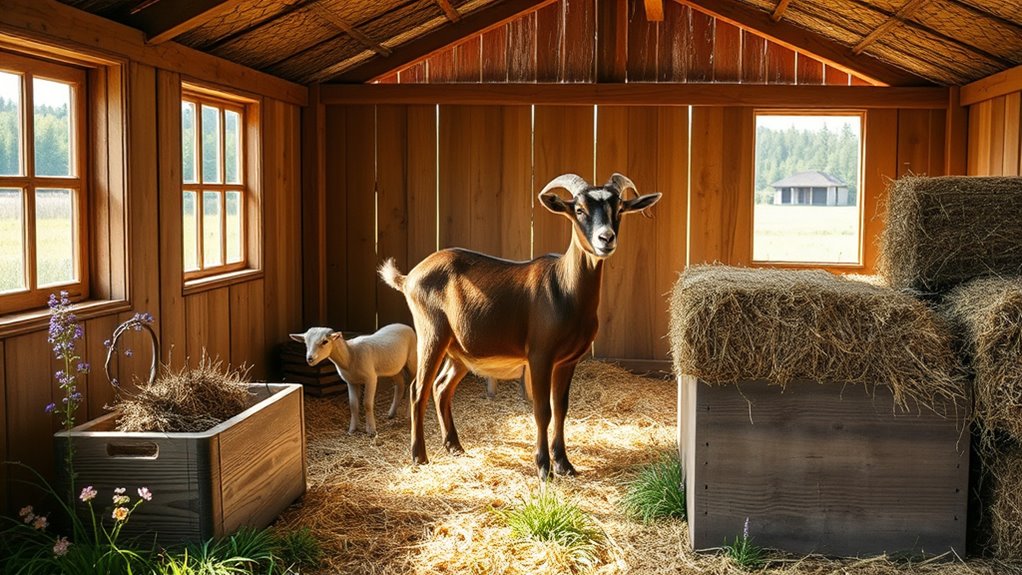
While goats can thrive in various environments, managing their shelter effectively is crucial for their health and well-being.
You should consider building three-sided shelters that provide wind protection and keep your goats dry. Portable shelters are great for relocation as your herd grows. Use durable materials, like drill pipe, to withstand heavy snow loads.
Ensure your shelter has proper ventilation and drainage to prevent moisture buildup. Sloped terrain helps keep water from pooling, and sun exposure allows your goats to sunbathe.
Incorporate large openings for easy access and secondary shelters for shy goats. Regularly clean and maintain bedding to keep your goats comfortable, and plan for future expansions with flexible designs that adapt to changes in your herd.
Grooming and Hygiene Practices

Grooming and hygiene practices are essential for keeping your pregnant goats healthy and comfortable. Regular hoof trimming prevents sore hooves that can arise from weight gain and hormonal shifts.
Trim the long hairs around their tails and legs to ease post-kidding cleanup, and keep teats clean and trimmed to prevent infections and facilitate easier milking.
Maintain clean living conditions to reduce the risk of infections, and regularly disinfect equipment and spaces. Proper waste management is vital for a healthy environment, and ensure fresh, clean water is always available.
Regular veterinary checks will help catch health issues early, while monitoring weight and parasite control is crucial for their well-being during pregnancy.
Preparing for Kidding
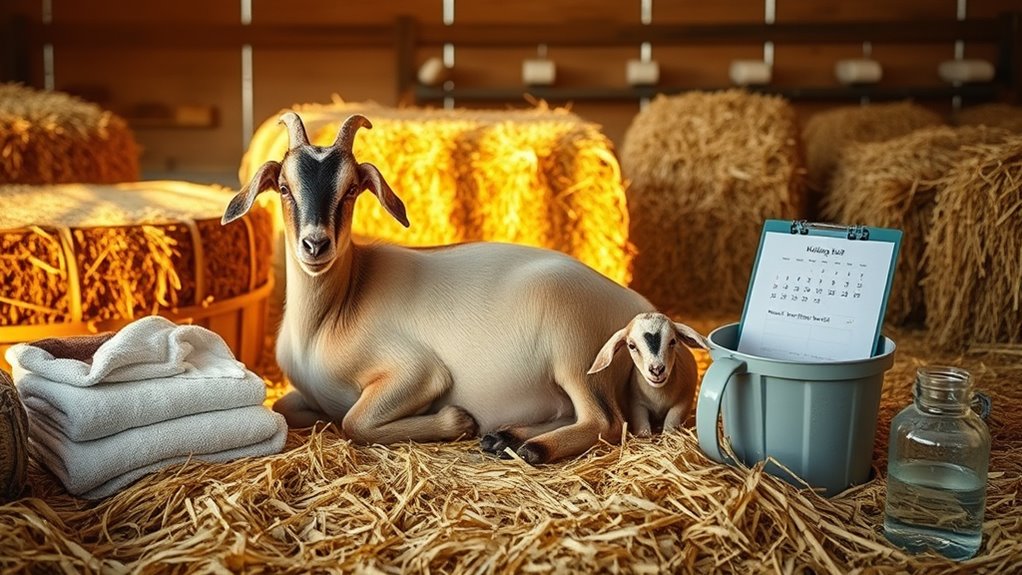
Preparing for kidding involves several crucial steps to ensure the health and safety of both the doe and her newborns.
Start by thoroughly cleaning and disinfecting the facilities to minimize bacterial risks. Use fresh straw for bedding to keep the area dry and comfortable. Protect the shelter from drafts while ensuring proper ventilation. If it's cold, prepare heat sources like heat lamps.
Thoroughly clean and disinfect facilities, use fresh bedding, ensure ventilation, and prepare heat sources for a safe kidding environment.
Select a pasture that hasn't been grazed in at least 60 days to lower parasite risk. Administer CD&T vaccinations four weeks prior, deworm at kidding, and trim hooves two months before.
Gradually introduce grain a month before kidding to support fetal growth. Lastly, monitor the doe closely for signs of labor and prepare a private stall for her.
Essential Supplies for the Kidding Kit

As you get ready for the arrival of newborn goats, having the right supplies on hand can make all the difference during kidding.
Start with essential tools like a nasal aspirator for clearing mucus, scissors, and dental floss for umbilical cords, and iodine to prevent infection. Don't forget OB gloves for handling newborns safely.
For hygiene, stock up on Betadine, chlorhexidine scrub, and antibacterial soap to keep everything clean.
Health supplies, like a thermometer and colostrum replacer, are crucial for monitoring and feeding.
Comfort items like towels, a heat lamp, and puppy pads will help keep the kids warm and dry.
Lastly, keep a flashlight, trash bags, and veterinarian contact information handy for emergencies.
Post-Kidding Care for Does and Kids
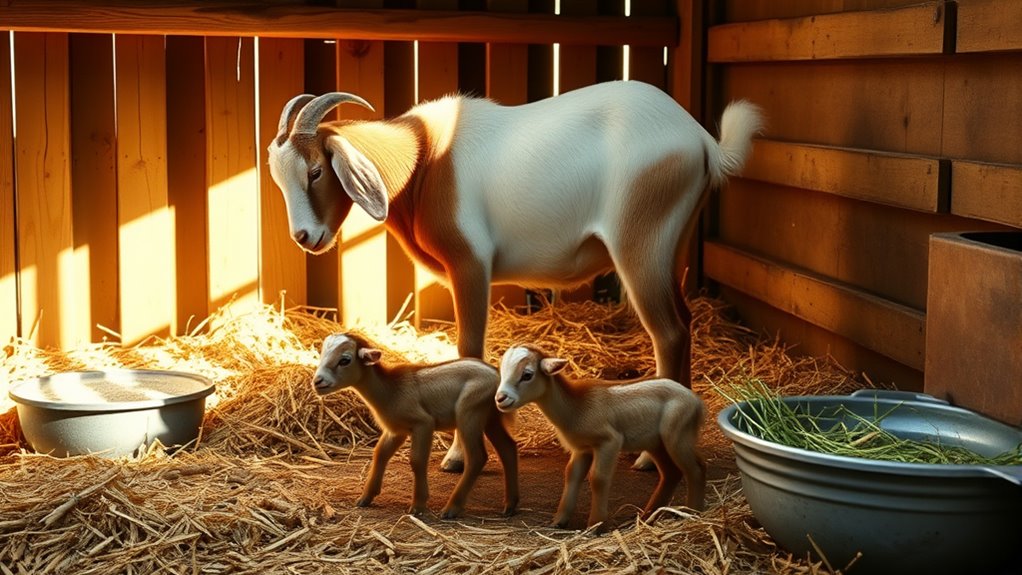
Once your kids arrive, focusing on their care and the health of the doe is crucial for ensuring a successful transition into motherhood.
Start by providing your doe with high-quality hay, like alfalfa, and gradually introduce grains to boost her energy for milk production. Don't forget free-choice mineral supplements to maintain her calcium levels.
Monitor her udder for signs of mastitis and administer dewormers to prevent parasites.
For the kids, ensure they ingest colostrum within the first 24 hours and assist them with nursing if needed. Trim and disinfect their umbilical cords, and keep them warm with heat lamps.
Finally, keep the environment clean and provide a small pen for bonding during those first crucial days.
Monitoring and Managing Newborn Health
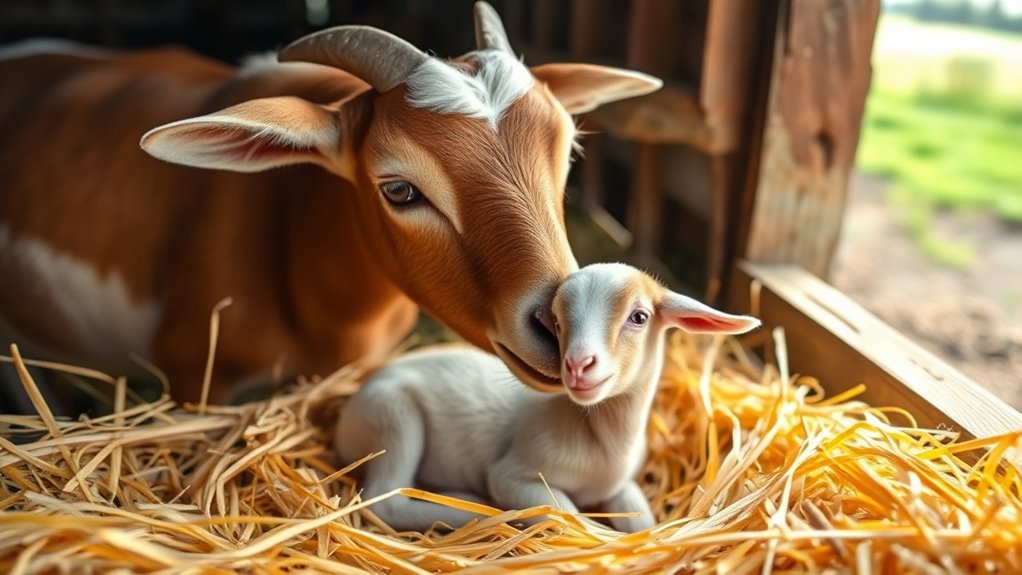
After ensuring the doe and her kids are settling in well, it's important to focus on monitoring and managing the health of the newborns.
Start by checking each kid's breathing and clearing any airway blockages. Encourage them to suckle early for essential colostrum intake, which boosts their immunity.
Regularly monitor their vital signs—temperature, pulse, and respiration—keeping them within normal ranges. Conduct a physical exam to spot any abnormalities.
Don't forget umbilical cord care; trim and disinfect it to prevent infection. Keep an eye on the navel for signs of infection, and use iodine as needed.
Finally, maintain a clean environment to minimize disease risks while observing their behavior and overall health closely.
Frequently Asked Questions
How Can I Tell if My Goat Is in Labor?
To tell if your goat's in labor, watch for signs like restlessness and nesting behavior.
You might notice her separating from the herd and becoming more vocal.
Check for physical changes too, such as a softening of the tail ligaments and a full, stiff udder.
As labor progresses, look for visible contractions, pushing, and swelling of the vulva.
If you see these signs, prepare for the arrival of the kids!
What Signs Indicate a Goat Is Having Complications During Delivery?
If you notice your goat struggling during delivery, look for signs of complications.
Extended labor over eight hours, lack of progress after 30 minutes of pushing, or abnormal presentations like rear legs in the birth canal are red flags.
Watch for signs of distress, such as fatigue or bleeding, and ensure the placenta is delivered within 12 hours post-birth.
These indicators require immediate attention, so don't hesitate to call a vet for help.
Can I Breed My Goat Again Immediately After Kidding?
So, you think your goat's ready for another round of motherhood right after her last?
While she can technically get pregnant in less than 30 days, it's not a race. Rushing her can stress her out, especially if she's still nursing.
Make sure she's in tip-top shape and getting the right nutrition.
Staggering breeding times might save you from a goat drama series—trust me, it's better for everyone involved.
How Long Should I Wait to Handle Newborn Kids?
You should wait at least 24 to 48 hours before handling newborn kids. This time allows the mother and kids to bond naturally, which is crucial for their emotional and physical development.
During this period, monitor them from a distance to ensure they're nursing well and staying warm.
After the initial bonding phase, you can gently handle the kids, but always prioritize their comfort and the mother's well-being.
What Are Common Postpartum Complications to Watch For?
In the grand tapestry of livestock husbandry, you'll want to keep a vigilant eye on common postpartum complications.
Look out for uterine tears, retained fetal membranes, and metritis, as these can escalate quickly. Uterine prolapse and periparturient hemorrhage also require immediate action.
Monitoring and providing proper care can prevent serious issues. Stay proactive and address any signs of distress promptly to ensure your does recover smoothly after delivery.
Conclusion
In the grand tapestry of goat motherhood, your care during pregnancy weaves a bright future for both does and kids. By nurturing their nutritional needs and creating a cozy haven, you're setting the stage for a successful kidding season. Just as a gardener tends to each seedling, your attention ensures healthy growth and vibrant life. Remember, the journey doesn't end with birth; by monitoring their health, you cultivate a thriving flock that'll flourish for seasons to come.

